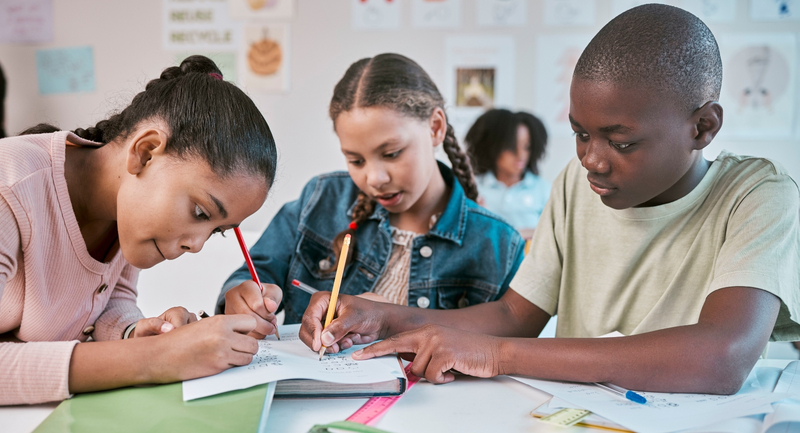As the author of a book about classroom conversations on race, I’ve had many surreal experiences and interactions. None have given me more insight than the experiences I’ve had at book signings.
Educators of color, I’ve found, love to share racial horror stories with me. We bond quickly over remembered incidents from our childhood classrooms, or egregious mistakes made by our children’s teachers. It’s also common for white teachers to approach me for absolution. They may have made a controversial curricular choice, or said something questionable to a student of color, or had a confrontation with a colleague — and they earnestly tell me every detail, sometimes awkwardly drawing the attention of other teachers in line. At the conclusion of the story, they ask some version of, “That was OK, right? That wasn’t racist.”
This judge-and-jury moment is likely familiar to people of color that move in mostly white spaces. We are used to being solicited for judgments on racism, as if we’re character witnesses for white people. When faced with this request at a book signing, I usually offer a reminder that racial issues are both complex and intimate, and that my opinion on the teacher’s situation is less important than those who lived it. In other words, talk to them. And listen more eagerly than you defend yourself, and you might get somewhere.
One recent version of this type of exchange has stuck with me. I had just keynoted a conference in the Deep South, and was still catching my breath at the book signing table when a white woman approached. Even as she generously complimented my presentation, her teary eyes suggested an emotional struggle. After an awkward stretch of small talk, she finally shared what was bothering her: “Just last year, one of my students told me that her grandmom just doesn’t like white people. Can you believe that?”
I wasn’t sure if I had heard her correctly and asked for clarification. “This is one of your students?”
She nodded vigorously, adding “I told her, ‘There are good white people and bad white people and good black people and bad black people.’ I mean, can you believe this? It’s so discouraging.” She then locked her eyes with mine, pleading silently for affirmation.
I was too uncomfortable to offer my best. I mumbled something about the “complexity” of these issues and thanked her again for buying my book.
But as I turned to other teachers in line, I began running some math in my head: I had not gotten the grade that this teacher taught, but if she taught in an elementary school, her students’ parents were probably Millennials like me. If she taught high schoolers, the parents might be Gen-Xers. In either case, this student’s grandparents could very well be Baby Boomers, born in the 1950s and early 60s.
Recent History
This means that for “grandmom,” just like my parents, the Jim Crow era wasn’t just a series of black-and-white photos in a textbook. When traveling in the South, “grandmom” may have passed the night wedged against siblings in a car by the roadside, just like my father did when visiting relatives in Georgia. There was likely a trove of difficult memories, such as my father had. He once told me about the time his family arrived at Grant Park in Atlanta, and my grandfather realized that he’d run out of film for his camera. Upset that he wouldn’t be able to photograph the famous Cyclorama, he walked to the nearest store and waited outside, scanning the faces of every white man that passed, hoping to find someone kind enough to take his money and buy the black family some film. My father remembered thinking, “Why doesn’t Dad just go into the store by himself?”After all, my grandpop was both a preacher and the president of a major Christian conference, a father of five working on his master’s degree, and a World War II veteran who had earned a Purple Heart fighting in Northern Italy. Surely he could buy a roll of film. But my dad, perhaps like this student’s grandmother, learned quickly the wages of blackness.
And perhaps there was more. When “grandmom’s” parents were born, it’s unlikely that they could vote, sit on juries, or simply walk unmolested down a public street after hours in certain parts of town. Even a generation later, this woman was likely raised in a state that still had laws mandating the treatment of black people as second-class citizens.
As a young person, she probably witnessed the struggle for civil rights. In her teenage years, she may have even marched, sat at a lunch counter, protested against a segregated school, enduring the taunts and violence as she worked to ensure Jim Crow’s destruction.
I don’t know this student’s grandmother. But I do know that, given the possible circumstances, it is not all that strange that she doesn’t like white people. I don’t share her willingness to blame all white people — with no recognition of earnest white allies — but I can empathize with her instinct. In her case, it might seem like the safest option.
I also do not know the teacher who talked to me about this. I do know that she is the kind of dedicated educator who attends national conferences. This, along with an armful of professional books that she carried over to my table, tells me that she is serious about her craft. But I don’t know anything else about her background or approach to teaching.
Sensitive Issues
However, as I reflected on our strange, brief interaction, I saw some lessons for every teacher who is interested in having meaningful conversations about race with their students.
First, underneath its surface, this teacher’s story should remind us that the black-and-white photo era that many label “racism times” or “back in the day” was actually not that long ago. (Of course, racism is not a thing of the past, but that’s a different conversation.) As teachers, we must do the math. For many people, the trauma of the Jim Crow era—and other forms of officially sanctioned racism—are not only real, but fresh. They sit in the living memory of some of the people our students care most about, people who may be their mentors or role models. Knowing this, we teachers cannot approach race conversations with cold academic distance. We must never be shocked by the vulnerability that such conversations require of our students. This also applies to our professional interactions with colleagues. Some educators may be more sensitive about discussing certain issues or engaging in certain activities than you realize.
Second, this incident should remind us that facilitating race discussions in schools is a heavy lift. During professional development sessions, I continually make the point that race work is hard, and anyone pushing easy solutions is selling snake oil. There is no packet, no curriculum, no single training that can magically solve a classroom’s race problems, let alone eliminate the ugly incidents that induce school districts to call in the consultants. So many errors, both strategic and tactical, begin with underestimating the intractability and depth of the problem.
Thinking More Slowly
I recently read the book Thinking Fast and Slow by Noble Prize-winner Daniel Kahneman. In the first chapter, Kahneman describes the difference between the two “characters” of our consciousness, the instinctive self that he names “System 1,” and the more meditative and analytical mind that he calls “System 2.” System 1 is the self that thinks “4” after hearing someone say “2+2,” and jumps to quick, instinctive conclusions about situations. This self, in Kahneman’s words, “operates automatically and quickly, with little or no effort and no sense of voluntary control.”
System 2 is more reflective and deliberative. One of its main tasks is to monitor and interrupt the autopiloted thoughts and actions “suggested” by System 1. For instance, when System 1 says, “That group of black children standing on that corner is about to rob me,” hopefully System 2 steps in to say, “Oh, calm down. They are just waiting for the bus.” When in the mood to do its job, System 2 takes the keys before System 1’s dependence on stereotypes steers us off a cliff.
Unfortunately, Kahneman argues, System 2 takes a lot more effort to put into action than System 1. It is typically more than willing to accept the knee-jerk conclusions offered up by System 1. Kahneman suggest that, to tap System 2 and be our best thinking selves, we must able to mistrust our first impressions and bring critical knowledge to bear on a situation. In other words, we teachers need to rely on the information that our conscientious selves acquire—from the books we read, the conferences we attend, and the relationships we develop, while actively knowing that our System 1 will always tempt us to lose our vigilance.
Improving Relationships, Conversations
So let’s examine my book-signing conversation through Kahneman’s lens. Upon hearing that her student’s grandmother didn’t like white people, this teacher, from what I could tell, chose to ride System 1’s easy momentum and take personal offense. Once this instinctive fragility becomes a habit, teachers often find themselves too insecure to build healthy classroom ecosystems where honest race conversations can flourish. Or worse, their insecurity causes them to meet perceived insult with actual hostility.
But what if the teacher had forced her System 2 to clock in and sought to understand the context undergirding the grandmother’s opinion? She might have gotten a glimpse of why this older woman engaged white people (teachers included) with wariness — just as, frankly, many students and families of color do. While this knowledge may have been uncomfortable for the teacher, it wouldn’t have to be completely discouraging. We may always struggle to earn the trust and respect of the diverse communities we serve, but we can do our best to understand their perspective and do our best to make them feel welcome.
What if, when this grandmother attends her granddaughter’s first basketball game, concert, or poetry slam; when she comes in for a conference; or when she speaks to any member of the school staff, she is met with a passionate cohort of teachers showing her that they treat her grandbaby as if she were their own. If in the end, she still “doesn’t like white people,” that’s her prerogative. We should consider it a humbling reminder of the very real, very fresh, very understandable wounds that have no magic redress.
All we can do is work to improve conversations and relationships.
About the author
Matthew Kay is a founding English teacher at Science Leadership Academy in Philadelphia, and author of Not Light, But Fire: How to Lead Meaningful Race Conversations in the Classroom (Stenhouse, 2018). Starting this fall, he will be a regular columnist for Educational Leadership. Find him on Twitter at @MattRKay.








